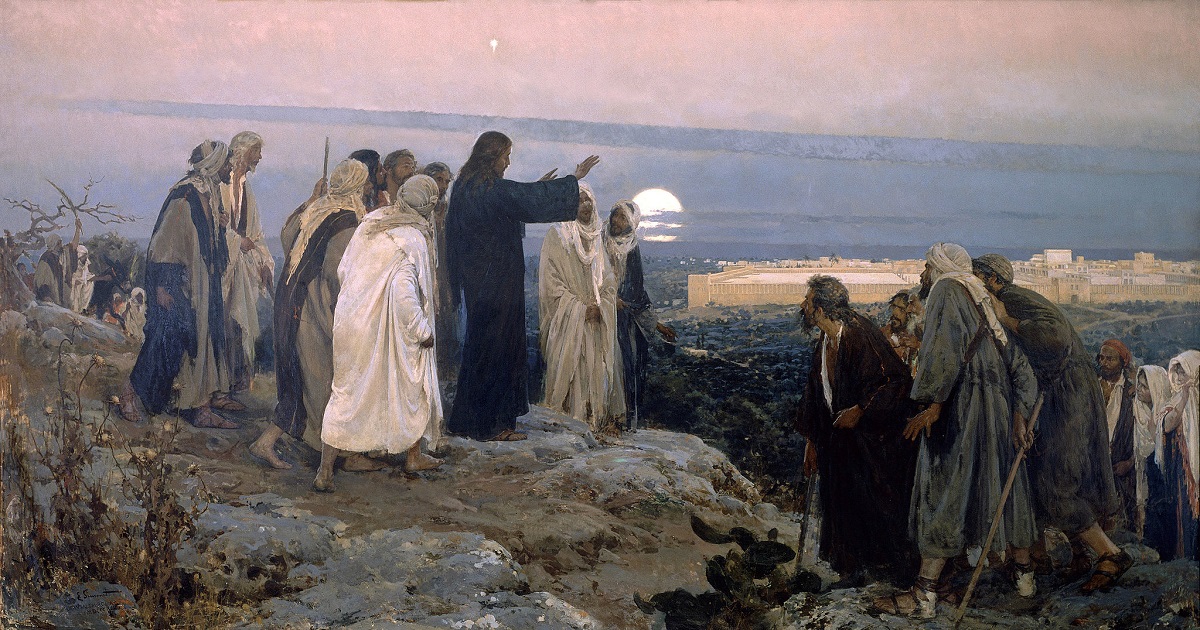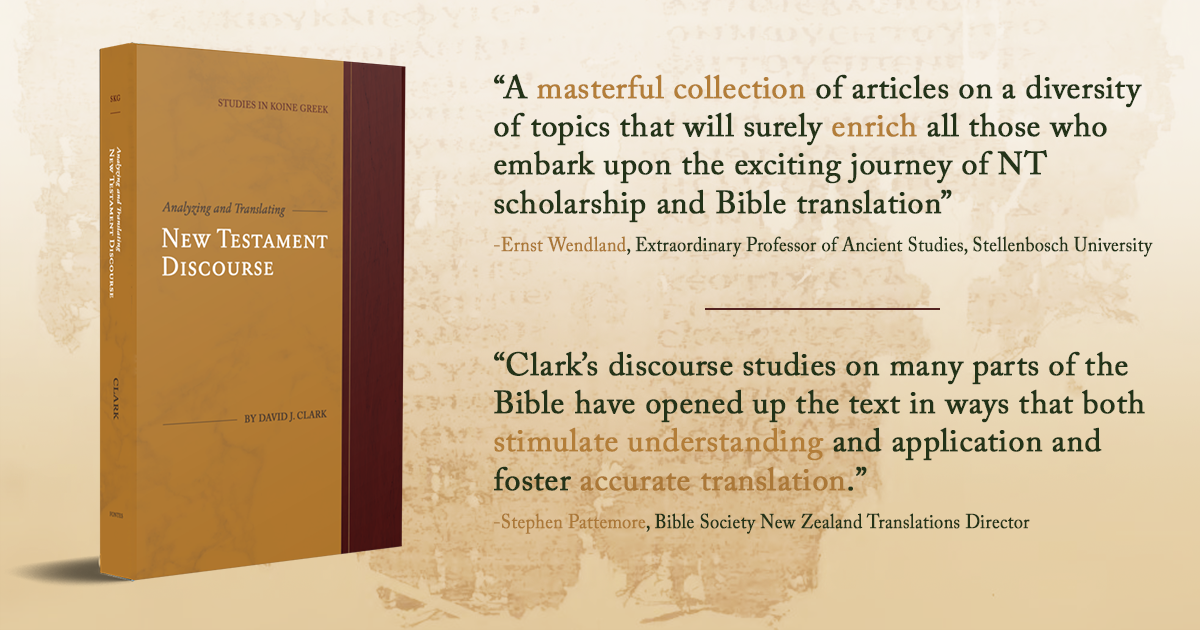
Matthew 24-25 is usually referred to as the “Eschatological Discourse.” But is that really the extent of it? Or is there more to it?
The Larger Structure of Matthew
The overall structure of Matthew’s Gospel has for a while now been recognized as alternating blocks of narrative (N) and discourse (D) blocks, with the contents designated roughly by chapter as follows:
N: 1-4
D: 5-7
N: 8-9
D: 10
N: 11-12
D: 13
N: 14-17
D: 18
N: 19-???
D: ???
N: 26-28
The Eschatological Discourse is located within the final discourse block. The end of the discourse block is signaled by the same phrase that signals to end of the previous four discourse blocks: ὅτε ἐτέλεσεν ὁ Ἰησοῦς πάντας τοὺς λόγους τούτους (“when Jesus finished all these words,” 26:1; cf. 7:28; 11:1; 13:53; 19:1).
The question is, where does the second-to-last narrative block end, and where does the final discourse block begin?
The Contents of Chs. 23 and 24-25
Chapter 23 begins in the temple in the last week of Jesus’ ministry (21:23). The audience includes both disciples and “the crowds.” In this chapter, Jesus blasts the scribes and the Pharisees, saying people should observe what they say, but not what they do (23:2-12). He delivers seven woes to them, describing them as “hypocrites” (23:13-36). Jesus then laments over Jerusalem for what seems to be a prophecy of its downfall and his future coming (23:37-39).
In 24:1, Jesus leaves the temple and as his disciples follow him, they point out the buildings of the temple to Jesus. ” Jesus responds, “You see all these, do you not? Truly, I say to you, there will not be left here one stone upon another that will not be thrown down” (24:2). After he moves to the Mount of Olives, “the disciples came to him privately, saying, ‘Tell us, when will these things be, and what will be the sign of your coming and of the end of the age?'” (24:3). These two questions are then unpacked in reverse order, with Jesus discussing the signs of the end of the age first (24:4-35) and the signs of his coming second (24:36-25:30).
Does Ch. 23 Belong with 24-25?
There seem to be good reasons for excluding ch. 23 from the eschatological discourse. There is a change of scenery from the temple to the Mount of Olives. The audience includes the crowds in the temple, but only the disciples on the Mount of Olives. The content of chs. 24-25 is described as “eschatological” by most (albeit, the content varies and shifts), while the content of ch. 23 is yet another attack on the religious establishment.
But there are better reasons for including ch. 23 in the eschatological discourse. First, the entire discourse clearly begins in ch. 23 and the discourse-ending formula does not occur until 26:1. Second, while there is a change of setting, chs. 24–25 are spoken in response to the disciples pointing out the buildings of the temple to Jesus (24:1–3), where they had just left (ch. 23). Third, chs. 23 and 24 both contain judgments on the religious authorities. Fourth, while the crowds do not follow Jesus to the Mount of Olives, the disciples do and are therefore a point of continuity between chs. 23 and 24-25. Fifth, Jesus’ lament over Jerusalem’s impending downfall at the end of ch. 23 foreshadows the same in ch. 24. Finally, There is a similar change of setting in ch. 13 (the parables chapter), which is not taken to signal two distinct discourses.
The eschatological discourse (or Olivet Discourse if one is averse to the E-word) therefore should be considered to begin in ch. 23.
So what?
Close attention to the discourse structure of Matthew’s Gospel helps us to better define the boundaries of certain discourses and narratives, in this case, that of the eschatological discourse. But why does this matter?
Texts have units with boundaries, and each unit has a topic (or topics). Discourse topics are defined variously by linguists, but it is certain that if a unit of text appears under the heading of one topic as opposed to another, that will affect its interpretation. In this case, including ch. 23 in Jesus’ eschatological/Olivet discourse helps us better understand both ch. 23 and chs. 24-25.
Ch. 23 focuses heavily on woes against the establishment, so we should expect to see a similar theme in chs. 24-25, which we do. But there is much debate on how much of chs. 24-25 is about Jerusalem in the first century, and how much is oriented toward Jesus’ second coming (while some see AD 70 as Jesus’ second coming). Perhaps this connection between the chapters should lead us to see more condemnation on first century Israel in chs. 24-25, but this would need to be borne out by exegesis as well.
Again, ch. 23 begins in the temple, while chs. 24-25 is occasioned by the disciples’ mention of the temple. We should therefore expect much of chs. 24-25 to relate to the temple, and perhaps more of it does relate than is obvious at first sight. Matthew seems to be intending such, given the way he weaves this narrative together with such thematic coherence.
Finally, is ch. 23 “eschatological” at all? Jesus has denounced the religious establishment throughout Matthew. Now ch. 23’s denouncements is part of a larger eschatological discourse. Is there some sort of eschatological significance to Jesus’ ongoing battles with the Pharisees, Sadducees, and scribes?
More could be said, but this much suffices to show the value of rigorously executed discourse analysis, even on longer texts such as the Gospels. Discourse analysis can change how we view entire chapters or stretches of text, if we realize that the author uses linguistic cues to signal some sort of connection.
These observations have been taken from David Clark’s new collected essays on discourse analysis of New Testament documents and phrases, Analyzing and Translating New Testament Discourse. Clark’s discourse analysis of Matthew was published in 1982 in Scriptura, but has gone by unnoticed. His book also includes a discourse analysis of Ephesians, 1 and 2 Thessalonians, 3 John, Jude, Titus, and the Sermon on the Plain. He has three important essays on the socio-linguistic significance of displaced vocatives, three essays on “truly (truly) I say to you” as a discourse marker in the Gospel, and two essays on the translation issues involved with key phrases in the Gospels.


